by Daniel J. Leonard | Aug 11, 2017
Growing in containers can be one of the most versatile ways to add color, texture and mobility to the landscape. However, gardeners generally reach for finicky annuals to fill their pots with pizzazz. The problem with this strategy is that most annuals and perennials need to be watered constantly, fertilized regularly, and changed out with the seasons. That sounds like a little bang for a whole lot of buck! I and most of the real plant people I know fall squarely in the school of lazy gardening and believe there is an easier, less intensive, and ultimately less expensive way to get the same result. This can be accomplished by thinking outside the box and using an alternative class of plants that can fit the same bill of providing color and texture in pots without the headaches and have been sitting on the shelves right in front of us the whole time, the shrubs.
It is beyond me why shrubs aren’t used as container plants more often. Maybe the reason for the lack of use is pure perception; after all, no one with any sense would plant a giant, coarse green meatball or an enormous antebellum azalea in a decorative pot on their front walk. Recent innovations by plant breeders have left this argument moot though as new introductions of old species have revived interest in the entire group. Many of the best of these new cultivars sport traits perfect for container culture (dwarf growth habit, increased flowering, and interesting texture and form) while preserving the ironclad, undemanding nature of their parent plants. The following are a few of my favorite new shrub introductions for container growing!
- ‘Purple Pixie’ Loropetalum
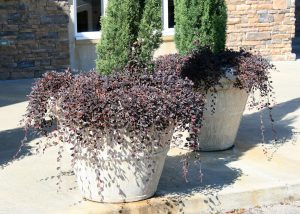
Purple Pixie loropetalum is a low-growing shrub that can spill beautifully out of a container. (Photo by MSU Extension Service/Gary Bachman)
If interesting architecture is what you require in a plant, ‘Purple Pixie’ must be on display in your yard. This dwarf cultivar of the wildly overused purple shrub Loropetalum chinense has taken the horticultural world by storm. The unique combination of true purplish foliage that only greens slightly in the hottest summer sun, ribbon-like pink spring flowers, and a graceful weeping habit make ‘Purple Pixie’ a winner. Give this plant a medium sized container (at least 12” in diameter), water when the soil begins to dry, fertilize infrequently with a slow-release formulation, site in full sun to partial shade, and enjoy for many seasons to come.
This is definitely not your granddaddy’s Ligustrum. Gone are the rampant growth, sickly sweet smelling flowers, and the aggressive nature of ‘Sunshine’s’ parent Chinese Privet (Ligustrum sinense). ‘Sunshine’ is a sterile cultivar with dwarf characteristics (growing 4-5’ with infrequent light pruning), vivid yellow-chartreuse foliage, and most importantly, no flowers. All ‘Sunshine’ asks of us is plenty of sun, occasional fertilizer and a light haircut once or twice a season! Use this plant to frame a dark flowerbed or in a container as a companion to the previous plant, ‘Purple Pixie’ Loropetalum for an extremely striking combination!
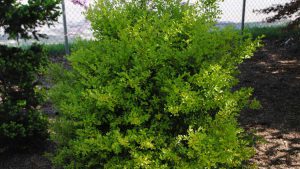
‘Sunshine’ Ligustrum. Photo courtesy of JC Raulston Arboretum.
A new take on a landscape standard, ‘Baby Gem’ is an exceptionally compact and slow growing cultivar of Buxus microphylla var japonica. All the same features gardeners love about traditional “full-size” boxwoods remains (tight, formal growth habit, ability to prune into many different shapes and ironclad constitution) but with ‘Baby Gem’ are delivered in a perfect package for a pot. This little “gem” of a plant is perfect for use in a smallish container to frame a formal landscape or to give a sense of order to an informal container garden or border!
So if you’re ready to stop replacing all of your potted plants each and every season, reach for one of these shrubs the next time you are at a garden center. You’ll likely be rewarded with compliments on your creativity, four season interest from the plants themselves, and more time to enjoy being in your garden instead of laboring in it! As always, if you have any questions about this or any other horticultural topics please contact your local UF/IFAS Extension office! Happy Gardening!

by Daniel J. Leonard | Jul 5, 2017
Let’s be honest with each other and have a moment of transparency, one gardener to another. Even though we are plant people, most of us get a lot less enthusiastic once the mercury explodes over 90 degrees each June. All the things that were fun in the spring (watering our favorite fickle plants, deadheading spent flowers, staking, tying, fertilizing, the list goes on) have ceased to be fun. At this point, like a baby bird pushed out of the nest, the plants in our yards have to either fly or die. Fortunately, if we select the correct, tough-as-nails plants to start with, our gardens do not have to decline when we retreat into the air conditioning! The following are four of my favorite ironclad native perennials that will reward you with color, texture, and overall excellent performance all summer and ask very little in return!

Black-Eyed Susan ‘Goldsturm’ (Rudbeckia fulgida var. sullivanti ‘Goldsturm’)
There is no more reliable plant in the garden than plain old Black-Eyed Susan. This beauty delivers yellow-gold flowers with its namesake black, cone-like centers perpetually from May to frost in the Panhandle and returns like clockwork each spring to do it all over again! While not exactly native, the 1937 selection ‘Goldsturm’ is still easily the most popular Rudbeckia eighty years later, with good reason. ‘Goldsturm’ improves upon the native Rudbeckias in almost every way. It is a more compact plant, forming a spreading mass of flowers about two feet in height, sports larger, showier flowers than the species, and flaunts lustrous dark green foliage. If low-maintenance, raw flower power is what you are after, Black-Eyed Susan ‘Goldsturm’ is right for you!
If the landscape calls for a plant with flowers hotter than the July sun, Scarlet Sage is hard to beat! This tough, prolific perennial boasts fire engine red, tubular-shaped flowers throughout the warm season in Northwest Florida and is one of the very best attractors of a host of pollinators including butterflies and hummingbirds. Growing this native couldn’t be easier, it is not picky about soil type and texture so long as it doesn’t stay waterlogged, it requires little to no supplemental fertilizer or water, and will thrive in full sun or partial shade. A word of warning before planting Scarlet Sage however, be aware that the plant will self-sow prolifically, potentially appearing in unwanted places and becoming a nuisance. Though with a plant this undemanding and pretty, I do not mind one bit if it decides to ramble through the landscape.
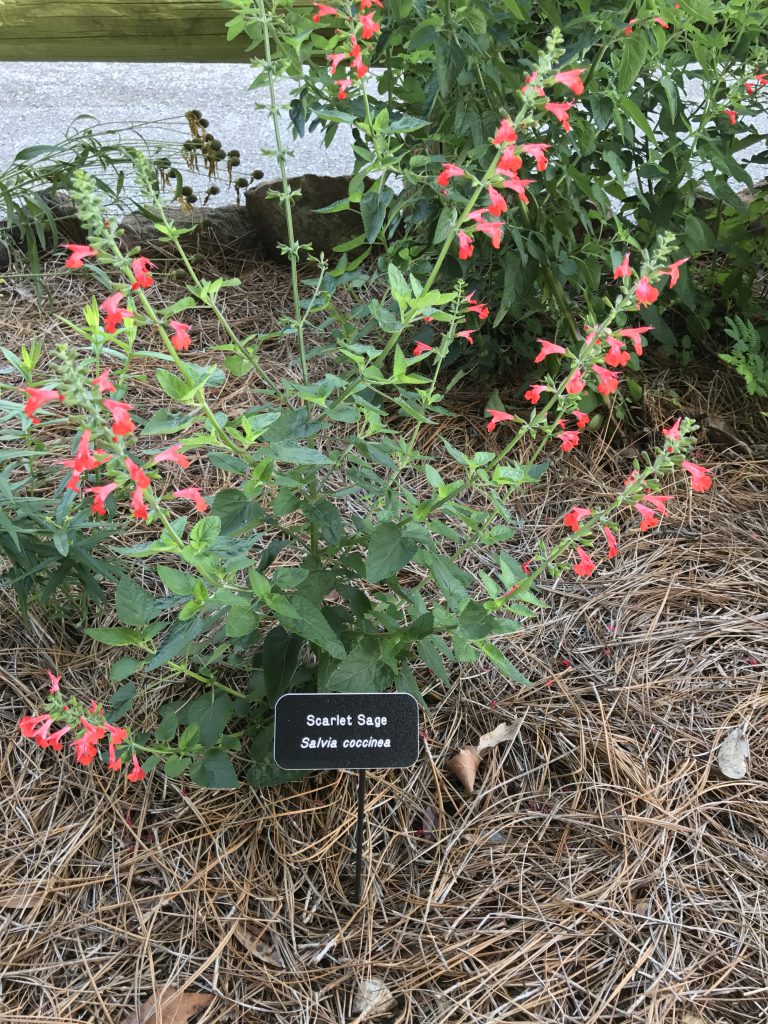
Scarlet Sage (Salvia coccinea)
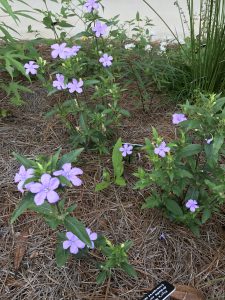
Carolina Petunia (Ruellia caroliniensis) (note: Not to be confused with Mexican Petunia (Ruellia simplex), which, despite its popularity, is an invasive weed and should not be planted)
For those of you that lament hot weather because it means the decline of the showy annual petunias sold by the thousands at big box stores across the South, there is a summer solution for you! Carolina Petunia is a compact (growing to 24” in height), hardy plant whose many outstanding ornamental qualities, including soft purple flowers produced in profusion, make it a great addition to virtually any garden border. It is not picky regarding soil and while flowering is best in full sun, it grows just fine in the dappled shade of pines or other taller perennials and shrubs. Like Scarlet Sage, Carolina Petunia will seed around in the landscape but is easily managed and never wears out its welcome.
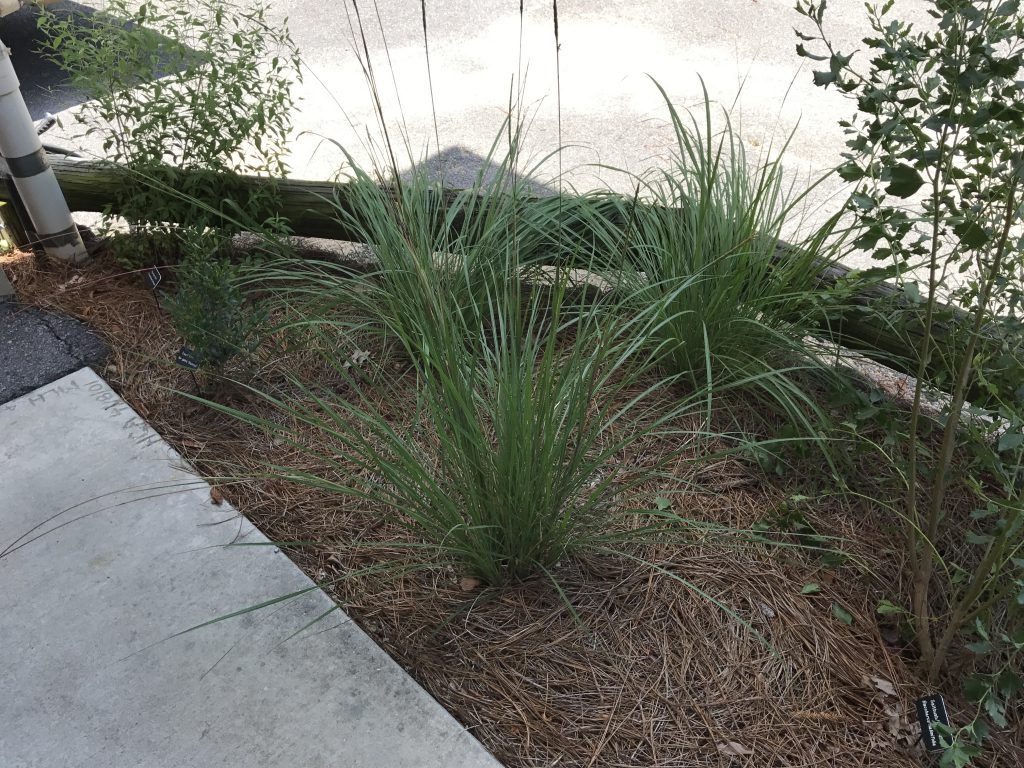
Dwarf Fakahatchee Grass (Tripsacum floridanum)
Ornamental grasses have gained in popularity over the last few years and with good reason! Ornamental grasses tend to be drought tolerant, laugh at the summer sun, and require little maintenance. However, many popular ornamental grass species like Miscanthus, Muhlenbergia, Pennisetum, and others tend to grow too large for most gardens and end up being replaced a few years later. Dwarf Fakahatchee fits this niche perfectly, with its emerald green leaf blades only growing 2-3’ in height and width. It is also more adaptable than most ornamental grass species as it will thrive in sun or partial shade and is tolerant of both wet and dry sites! While it lacks the colorful flower panicles of Muhly Grass or Miscanthus, Dwarf Fakahatchee does possess interesting brown flower stalks and seed heads as well!
All of these awesome low-maintenance, native perennial selections can be purchased at member nurseries of FANN (Florida Association of Native Nurseries) or local independent garden centers. As always, if you have any questions about this or other horticultural topics, contact your local UF/IFAS County Extension Office.
by Daniel J. Leonard | May 18, 2017
If you’re like me, growing turfgrass is often more of a hassle than anything else. Regardless of the species you plant, none tolerates shade well and it can seem like there is a never-ending list of chores and expenses that accompany lawn grass: mowing (at least one a week during the summer), fertilizing, and constantly battling weeds, disease and bugs. Wouldn’t it be nice if there were an acceptable alternative, at least for the parts of the lawn that get a little less foot traffic or are shady? Turns out there is! Enter the wonderful world of perennial groundcovers!
Perennial groundcovers are just that, plants that are either evergreen or herbaceous (killed to the ground by frost, similar to turfgrass) and are aggressive enough to cover the ground quickly. Once established, these solid masses of stylish, easy to grow plants serve many of the same functions traditional turf lawns do without all the hassle: choke out weeds, provide pleasing aesthetics, reduce erosion and runoff, and provide a habitat for beneficial insects and wildlife.
The two most common turfgrass replacements found in Northwest Florida are Ornamental Perennial Peanut (Arachis glabra) and Asiatic Jasmine (Trachelospermum asiaticum); though a native species of Mimosa (Mimosa strigillosa) is gaining popularity also. All of these plants are outstanding groundcovers but each fills a specific niche in the landscape.

Perennial Peanut Lawn
Perennial Peanut is a beautiful, aggressive groundcover that spreads through underground rhizomes and possesses showy yellow flowers throughout the year; the show stops only in the coldest winters when the plant is burned back to the ground by frost. It thrives in sunny, well-drained soils, needs no supplemental irrigation once established and because it is a legume, requires little to no supplemental fertilizer. It even thrives in coastal areas that are subject to periodic salt spray! If Perennial Peanut ever begins to look a little unkempt, a quick mowing at 3-4” will enhance its appearance.

Asiatic Jasmine
Asiatic Jasmine is a superb, vining groundcover option for areas that receive partial to full shade, though it will tolerate full sun. This evergreen plant sports glossy dark green foliage and is extremely aggressive (lending itself to very rapid establishment). Though not as vigorous a climber as its more well-known cousin Confederate Jasmine (Trachelospermum jasminoides), Asiatic Jasmine will eventually begin to slowly climb trees and other structures once it is fully established; this habit is easily controlled with infrequent pruning. Do not look for flowers on this vining groundcover however, as it does not initiate the bloom cycle unless allowed to climb.

Sunshine Mimosa
For those that prefer an all-native landscape, Sunshine Mimosa (Mimosa strigillosa), also known as Sensitive Plant, is a fantastic groundcover option for full-sun situations. This herbaceous perennial is very striking in flower, sending up bright pink, fiber-optic like blooms about 6” above the foliage all summer long! Sunshine Mimosa, like Perennial Peanut, is a legume so fertility needs are very low. It is also exceptionally drought tolerant and thrives in the deepest sands. If there is a dry problem spot in your lawn that receives full sun, you can’t go wrong with this one!
As a rule, the method of establishing groundcovers as turfgrass replacements takes a bit longer than with laying sod, which allows for an “instant” lawn. With groundcovers, sprigging containerized plants is most common as this is how the majority of these species are grown in production nurseries. This process involves planting the containerized sprigs on a grid in the planting area no more than 12” apart. The sprigs may be planted closer together (8”-10”) if more rapid establishment is desired.
During the establishment phase, weed control is critical to ensure proper development of the groundcover. The first step to reduce competitive weeds is to clean the site thoroughly before planting with a non-selective herbicide such as Glyphosate. After planting, grassy weeds may be treated with one of the selective herbicides Fusilade, Poast, Select, or Prism. Unfortunately, there are not any chemical treatments for broadleaf weed control in ornamental groundcovers but these can be managed by mowing or hand pulling and will eventually be choked out by the groundcover.
If you are tired of the turfgrass life and want some relief, try an ornamental groundcover instead! They are low-maintenance, cost effective, and very attractive! Happy gardening and as always, contact your local UF/IFAS County Extension Office for more information about this topic!
by Daniel J. Leonard | Apr 24, 2017
Almost every landscape has a problem area where the sun just doesn’t shine and many plants won’t make it, maybe it’s the north side of your house, under a small tree, or tucked away in an oddly-shaped alcove. We all know the same old boring green choices that work well here (Holly Fern, Cast Iron Plant, etc.) but maybe you want something a little bit different, something that will provide a pop of color and interesting texture! Look no further than a recent introduction, a whole-plant mutation discovered from the little-used Grape Holly (Mahonia spp.), aptly named ‘Soft Caress’.
‘Soft Caress’ Mahonia is a beautiful little evergreen shrub from the Southern Living Plant Collection (one of the best of the collection in my opinion) and really is a game changer for full-shade areas. Some of you may remember the traditional Mahonia, also known as Grape Holly, from your grandmother’s lawn. Those plants were coarse, spiny, produced messy purplish berries and often appeared generally unkempt. ‘Soft Caress’ is a major departure from its parent. Possessing finely-cut, deep green, bamboo-like foliage, this plant’s texture really contrasts well with many traditional shady species. As a bonus, ‘Soft Caress’ sends up brilliant yellow-gold flower spikes in the dead of winter, certainly a welcome respite from the other barren plants in the landscape; although in this unusually warm year, the plants are just now blooming in the Panhandle.

Photo courtesy: Daniel J. Leonard
‘Soft Caress’ is advertised to grow three feet in height and width, a more manageable size than the larger traditional Mahonia species, but I’m not sure I’d take that as gospel, the three-year old plants (hardly mature specimens) in my parent’s landscape are already that size and show no signs of slowing down. However, I’ve found you can easily manage their size with a once a year prune to slow down some of the more rapidly-growing canes. Be sure to time the prune as soon as possible after flowering is finished as ‘Soft Caress’ blooms only once a year and produces its flowers on the previous season’s wood, just like Indica Azaleas and old-fashioned Hydrangeas.
The uses in the landscape for ‘Soft Caress’ Mahonia are nearly endless. It pairs well with almost anything in a shady mixed shrub border. It works nicely as a foundation plant against a porch or under windows on the north or east side of a house where it will be protected from hot afternoon sun; I have employed a grouping of the plants in this way in my own lawn with success. It even thrives in containers! If you want to show off some serious horticultural design skills, mix ‘Soft Caress’ in a large container on the porch with some like-minded perennials for a low-maintenance, high-impact display that you don’t have to replant each season. All this shrub requires is partial to full shade, moist well-drained soil, and an occasional haircut to keep it looking tidy! If you’ve been struggling to find a plant that’s a little more unusual than the standard garden center fare and actually looks good in shady spots, you could do a lot worse than ‘Soft Caress’ Mahonia. 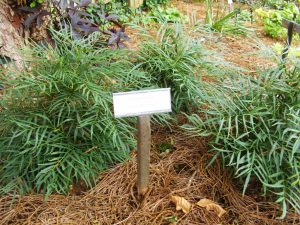
As always, happy gardening and contact your local UF/IFAS County Extension office for more information about this plant and other gardening questions!
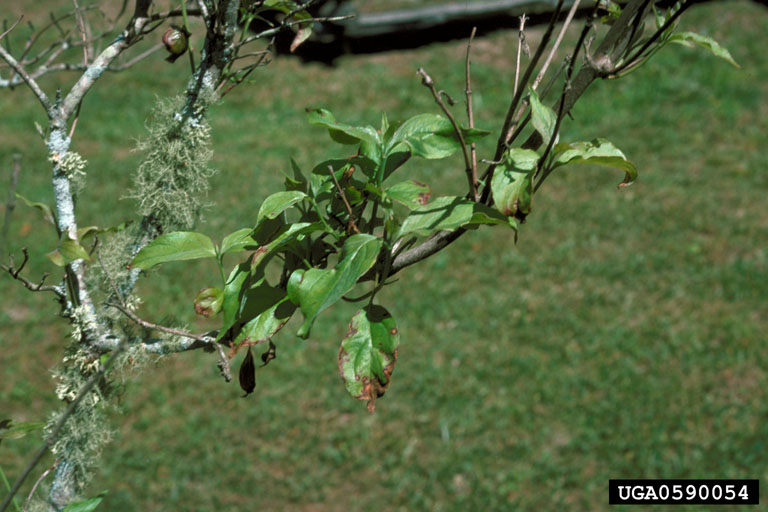
by Daniel J. Leonard | Mar 29, 2017
Everyone, or at least everyone fortunate enough to grow up in the South, has a fond memory tucked away of a sight or smell of a plant that reminds them of the good old days. Maybe it’s the ancient camellia at your grandmother’s house that just feels like home when you see it. Maybe it’s a persimmon tree with fruit weighing on the branches, the smell of baked persimmon bread cooling in the kitchen close behind. For me and countless others, it’s the sight of the iconic native flowering dogwood (Cornus florida) blooming each spring in the understory of Panhandle forests. However, if you’ve been paying attention, the spring dogwood bloom has diminished with each passing year, leaving many folks wondering what happened. As with many things, the answer is multi-faceted and complicated.
First, as homeowners who have grown dogwoods for many years are well aware, dogwoods are notoriously susceptible to harsh site conditions. In the landscape setting, much of the difficulty in growing dogwoods may be attributed to Florida’s frequent extended droughty periods and improperly citing the trees in a full-sun location. dogwoods naturally prefer a cool, moist root zone and protection from the hot afternoon sun; failure to provide such a setting will most likely lead to scorched-appearing foliage, overall poor performance and a short-lived tree.
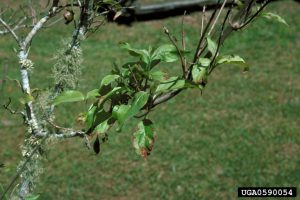
Various Dogwood Leaf Spots
More problematic are the many diseases dogwoods are prone to, including several fungal leaf spots, cankers and mildew diseases, all of which impair their ability to create energy and store the needed nutrients to survive tough periods (frequent droughts). All of these diseases are much more problematic in the unseasonably warm, wet winters and cool, wet springs Floridians have been experiencing with regularity over the last decade. It is good practice to actively clean up any fallen, diseased leaves as well as to prune out any obviously dead or diseased wood to prevent problems from spreading further, but total suppression of these diseases is impractical for most homeowners.
As if all of those problems weren’t enough, the most sobering issue currently facing flowering dogwood is a fungal disease known as dogwood anthracnose (Discula destructiva). D. destructiva has been confirmed responsible for the decline of dogwoods in more upland areas around the foothills of the Appalachians and has been surmised to have moved south into the coastal plain, although its presence in our area has largely been undocumented. As with other pathogens, disease incidence is increased in already stressed trees as well as in mild, wet-weather conditions in the spring and fall. Symptoms of D. destructiva usually begin with purplish spots on the margins of leaves in early summer, with infected leaves hanging onto the tree through winter. The disease then spreads down through the tree and manifests itself as a sort of dieback of twigs and limbs, eventually forming cankers and killing the tree.
As dire as the dogwood situation may seem, there are some potential solutions. First, if you must plant a flowering dogwood, make sure you give it an ideal situation. Irrigate when rainfall is inconsistent, apply a layer of an organic mulch (pinestraw, wood chips, etc.) at a depth of 2”-3”, and plant in a protected, shady situation. If growing a native dogwood might seem too challenging, there is a related species from Asia called kousa dogwood (Cornus kousa) that deserves to be planted more. Kousa dogwood is not a perfect tree but it retains most everything we love about native dogwoods without the disease issues!
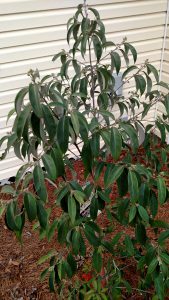
Young ‘Empress of China’ in the author’s lawn.
Kousa’s retain the classic creamy white flowers, attractive berries in fall, and layered branching (called sympodial branching) of our native dogwoods but also bring a few extra attributes to the table. Kousa dogwood grows to a rounded 15’-20 in height and width, is much more tolerant of cultural extremes than flowering dogwood and is resistant to the various diseases that plague native dogwoods. Also, there is a subspecies of kousa dogwood, Cornus kousa var. angustata that is even evergreen in our area, no more barren limbs in the winter! The most popular selection of this subspecies is a beautiful little tree being marketed as ‘Empress of China’ through the southern living plant collection; I am currently trialing this tree in my yard and it has impressed so far.
So to wrap up, if the decline of the dogwoods has you down, there are three things you can do:
- Give your existing dogwoods some TLC, keep them well-watered in droughty periods and mulch to keep the roots cool.
- Cut out any dead or diseased branches in existing dogwoods and rake and dispose of leaves from previous years that are lying around.
- If you want to plant a new dogwood, try a kousa dogwood (Cornus kousa) as this species is a more than adequate replacement for Cornus florida!
As always, consult your local UF/IFAS Extension Office with any questions or concerns you have regarding your landscape and happy gardening!















